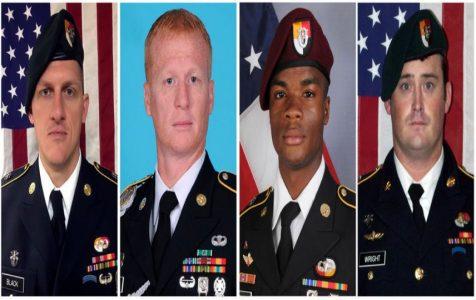
U.S. identifies 3 ISIS militants who led deadly ambush in Niger
The United States has identified at least three Islamic State leaders accused of planning and directing an ambush last October in Niger that killed four American soldiers, officials said, locking the American military in an additional and possibly lengthy campaign to hunt and kill members of a little-known extremist group in northwest Africa.
The group, known as ISIS in the Greater Sahara, claimed responsibility in January for the Oct. 4 attack. The group was designated a foreign terrorist organization by the State Department two weeks ago.
One of the three militants that led the ambush, Doundoun Cheffou, is most likely alive, according to government documents that were described to The New York Times by two United States military officials who were not authorized to discuss them publicly and spoke on the condition of anonymity.
The other two militants — Tinka ag Almouner and Al Mahmoud ag Baye, the latter of whom is believed to have trailed the team of Americans until shortly before they were attacked — were killed in the ambush.
Two higher-ranking militants are also likely alive and connected to the attack, although it is unclear how, according to one of the military officials.
Mr. Cheffou’s whereabouts is unknown, according to the documents. The American soldiers and Nigerien troops were searching for Mr. Cheffou, a one-time cattle herder and a senior lieutenant of a former affiliate of Al Qaeda, when they left their base on the fateful mission in October that is now code-named Operation Desolate Bastion by the Pentagon.
Representatives from American Special Operations Forces and the State Department — and, most likely, the C.I.A. — met at a base in Niger last month to examine a web of intelligence surrounding the ambush.
They singled out high-ranking militants that led the group of fighters that attacked the team of United States soldiers, including Green Berets, and their Nigerien counterparts. But the officials at the meeting also identified roughly 20 low-level fighters, according to the documents that outline the discussion. The Pentagon has said that the American team involved in the ambush killed 20 to 25 militants.
At the meeting, the officials also discussed methods to help track the militants who participated in and helped orchestrate the ambush — an endeavor that could take years. The American military and national intelligence agencies are still searching for the militants responsible for the Sept. 11, 2012, strike on diplomatic compounds in Benghazi, Libya, that killed four Americans, including Ambassador J. Christopher Stevens.
French and Nigerien security officials say ISIS in the Greater Sahara has 40 to 60 core members. It is often joined by sympathetic villagers, and it has temporary alliances with other local groups — two avenues of support that can be mobilized quickly.
The branch and its leader, Adnan Abu Walid al-Sahraoui, sought the recognition of the Islamic State in 2015 after breaking from Al-Mourabitoun, a Qaeda splinter group, according to a statement released by the State Department.
“This ambush made us really realize the threats out there are more organized than we thought,” Col. Maj. Moussa Salaou Barmou, the head of the Nigerien Special Forces, said in an interview last month, noting that the militants have also threatened village elders if they cooperate with the authorities. “Villages and hide-outs are only one or two hours apart, and the terrorists can react very fast.”
Mr. Cheffou has been connected to the kidnapping of an American aid worker, Jeffery Woodke, in Niger. In October, American intelligence agencies tracked his location to the Niger-Mali border by a ping from his cellphone. Mr. Cheffou was gone by the time the Special Forces team arrived at his camp, but hours later he was coordinating the fated ambush, according to the documents.
The Oct. 4 attack lasted hours, separating members of the 11-man American team. An abbreviated video released by the Pentagon on May 10 detailed parts of the ambush.
A few days later, the Pentagon released a fuller version of the video, showing that the American and Nigerien troops who survived the initial ambush were attacked a second time — by friendly fire from Nigerien military forces who had been sent to rescue the troops and mistook them for the enemy.
By then, four Nigerien troops, an interpreter and four American soldiers had been killed in the ambush. Around 12:50 p.m. — having been under fire for more than an hour — 11 American and Nigerien troops fled through a swamp and broke contact with pursuing fighters. They stopped at a clearing at the edge of the swamp and prepared to make a last stand, mounting a hasty defense.
They wrote short messages to their loved ones on personal devices, according to the video, believing they would soon be overrun. The arrival of French fighter jets, which made several low passes over the area, most likely saved the lives of the remaining team members by keeping the attackers at bay, the Pentagon has concluded.
But the team still was not out of danger. When the Nigerien response team arrived around 4:40 p.m. it “mistook the team members for enemy forces,” the video says, “firing on them for 48 seconds” with automatic weapons. No one was injured.
It was not until 4:55 p.m. that French commandos and Nigerien forces secured the area, enabling French helicopters to land and evacuate the survivors of the ambush.
Though the video asserted that none of the slain American troops were taken alive, the documents show that militants recovered the soldiers’ equipment, including advanced radios, night vision equipment, grenade launchers, personal rifles and some of the medium machine guns probably mounted to their vehicles.
In March, militias in Mali recovered a black sport utility vehicle that was driven by American troops during the ambush, along with an American medium machine gun and a sniper rifle that belonged to the team, according to the documents.
Source: NYT





